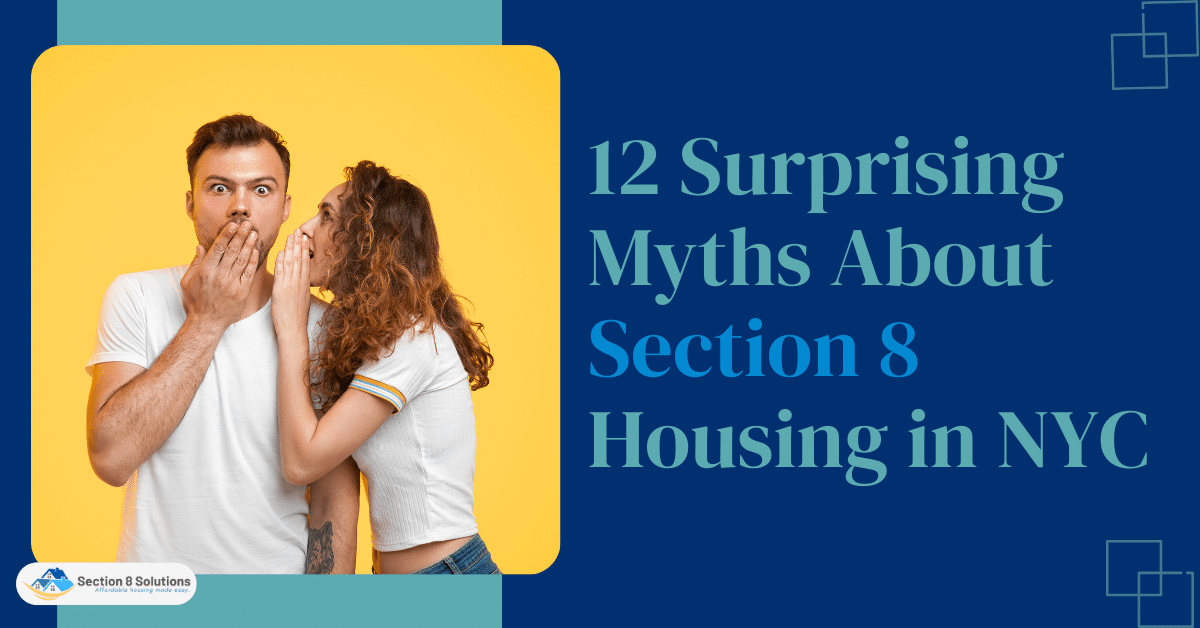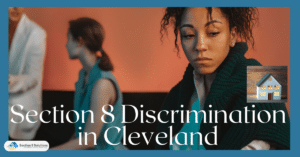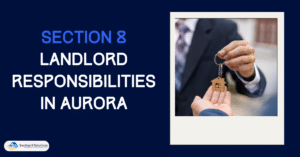The article discusses 12 myths surrounding Section 8 housing in NYC, including the misconceptions about property values and crime rates. It highlights the importance of understanding the facts and dispelling common myths surrounding affordable housing in NYC. The article aims to promote informed perspectives on Section 8 housing in NYC.
In this blog, we will explore 12 surprising myths about Section 8 Housing in NYC and debunk them with the facts.

Myth 1: Section 8 Housing Is Only for Unemployed People
That is not accurate. Section 8 Housing, also known as the Housing Choice Voucher Program, is a government-funded program designed to assist low-income individuals and families in securing affordable housing. While the program is often associated with those who are unemployed or underemployed, it is not limited to this group.
In fact, eligibility for the program is based primarily on income level, not employment status. To qualify for Section 8 Housing, applicants must have a household income that is at or below 50% of the median income for their area. This means that even those who are employed but have low wages may be eligible for the program.
In addition, certain groups are given priority for Section 8 Housing, including the elderly, disabled individuals, and families with children. However, this does not mean that others cannot apply for and receive assistance through the program.

Myth 2: Section 8 Housing Is Only for People With Large Families
One of the most common myths about Section 8 housing in NYC is that it’s only for people with large families. While it is true that families with children are often given priority when it comes to housing assistance, the program is not limited to them. Individuals, seniors, and small families can also qualify for Section 8 housing assistance in NYC.
The size of a household is just one of the factors that are considered when determining eligibility for Section 8 housing. Other factors include the household’s income, assets, and any disabilities or special needs that they may have. Eligibility for the program is determined on a case-by-case basis, and there are no blanket restrictions on the size of a household that can apply.
Furthermore, the size of a household can impact the amount of assistance that they receive, but it does not determine whether they are eligible for the program. For example, a single individual may qualify for less assistance than a family of four, but they can still receive rental assistance through the Section 8 program.
It’s important to note that while Section 8 housing is designed to provide affordable housing options to low-income individuals and families, it is not a permanent solution. The program is intended to provide temporary rental assistance while households work towards achieving self-sufficiency. This can include pursuing education or job training, seeking employment, or obtaining healthcare or other needed services.

Myth 3: Section 8 Housing Will Lower the Property Value of Surrounding Homes
Another common myth about Section 8 housing in NYC is that it will lower the property value of surrounding homes. This belief is often based on the assumption that Section 8 tenants are more likely to be disruptive or engage in criminal activity than other renters or homeowners. However, this assumption is not supported by the data.
Studies have shown that Section 8 housing does not harm property values in surrounding neighborhoods. Some studies have even found that the presence of Section 8 housing can have a positive impact on property values in certain areas. This may be because Section 8 housing can help to stabilize neighborhoods by reducing blight and increasing occupancy rates.
Furthermore, the Section 8 program has strict standards for the properties that are approved for rental assistance. Landlords must meet certain safety and sanitation requirements, and the properties must be inspected by the program to ensure that they meet these standards. This means that Section 8 housing is often well-maintained and can improve the quality of housing in surrounding neighborhoods.
It’s also important to note that discrimination against Section 8 tenants is illegal under federal law, and landlords who refuse to rent to Section 8 tenants can face legal consequences. This means that landlords are not free to discriminate against Section 8 tenants, even if they believe that their presence will lower property values.

Myth 4: Section 8 Housing Is Only Available in Low-Income Neighborhoods
Another common myth about Section 8 housing in NYC is that it’s only available in low-income neighborhoods. This belief is often based on the assumption that Section 8 housing is only located in areas with high poverty rates or that the program is limited to certain geographic areas. However, this is not true.
Section 8 housing is available in a wide range of neighborhoods throughout NYC, including many middle-class and even some affluent areas. Landlords who participate in the program are not limited to specific neighborhoods or zip codes, and tenants who receive rental assistance can choose where they want to live, as long as the property meets certain safety and sanitation standards.
Furthermore, the Section 8 program has a goal of helping low-income individuals and families achieve self-sufficiency, which means that it’s important for tenants to have access to a range of neighborhoods and services. This can include areas with good schools, job opportunities, and transportation options.
It’s also worth noting that Section 8 housing can have a positive impact on neighborhoods by increasing occupancy rates, reducing blight, and promoting community development. The program can help to create more diverse and inclusive communities by providing affordable housing options to a wide range of people.

Myth 5: Section 8 Housing Is Only Available for Minorities
Another common myth about Section 8 housing in NYC is that it’s only available for minorities. This belief is often based on the assumption that the program is designed to benefit certain groups over others. However, this is not true.
Section 8 housing is available to all low-income individuals and families who meet the eligibility requirements, regardless of their race, ethnicity, or national origin. The program is designed to provide affordable housing options to those who need it most, regardless of their background or demographics.
While it is true that minorities are more likely to be low-income and therefore eligible for Section 8 housing, the program is not limited to any particular racial or ethnic group. The Section 8 program prohibits discrimination based on race, color, national origin, religion, sex, familial status, or disability.
Furthermore, the Section 8 program is administered by the US Department of Housing and Urban Development (HUD), which has the mandate to promote fair housing and equal opportunity. HUD works to ensure that all individuals and families have access to safe, affordable housing, regardless of their race or ethnicity.

Myth 6: Section 8 Housing Is Only Available in High-Rise Buildings
Another common myth about Section 8 housing in NYC is that it’s only available in high-rise buildings. This belief is often based on the assumption that the program is limited to certain types of buildings or that it’s more common in urban areas with large apartment buildings. However, this is not true.
Section 8 housing is available in a wide range of buildings, including single-family homes, townhouses, and low-rise apartment buildings. Landlords who participate in the program can rent out a variety of different types of properties, as long as they meet the program’s safety and sanitation requirements.
While it is true that Section 8 housing is often located in urban areas with high population densities, this is not a requirement of the program. Tenants who receive rental assistance can choose where they want to live, as long as the property meets the program’s standards. This means that Section 8 housing is available in both urban and suburban areas throughout NYC.
The Section 8 program encourages landlords to participate in the program by offering a range of benefits, including guaranteed rental payments and free marketing services. Landlords who participate in the program can benefit from a steady stream of income and can help to provide affordable housing options to those who need it most.

Myth 7: Section 8 Housing Is a Burden on Taxpayers
Another common myth about Section 8 housing in NYC is that it’s a burden on taxpayers. This belief is often based on the assumption that the program is funded entirely by taxpayer dollars and that it provides a “handout” to low-income individuals and families. However, this is not entirely accurate.
While it’s true that the Section 8 program is funded in part by taxpayer dollars, it’s also funded through a combination of other sources, including private investment and tenant rent payments. Landlords who participate in the program receive guaranteed rental payments from the government, but they are also required to contribute a portion of the rent themselves.
Moreover, the cost of providing affordable housing options through the Section 8 program is often lower than the cost of other forms of public assistance. When individuals and families have access to safe, stable housing, they are less likely to require other forms of government assistance, such as emergency shelters, food assistance, or healthcare services. By providing affordable housing options, the Section 8 program can actually reduce the overall cost of public assistance programs.

Myth 8: Section 8 Housing is only for single-parent households
Another common myth about Section 8 housing in NYC is that it’s only available for single-parent households. This belief is often based on the assumption that the program is designed to help single-parent families, who are often in need of additional support. However, this is not entirely accurate.
Section 8 housing is available to all low-income individuals and families who meet the eligibility requirements, regardless of their household size or composition. The program is designed to provide affordable housing options to those who need it most, regardless of their family structure.
While it is true that single-parent households are more likely to be low-income and therefore eligible for Section 8 housing, the program is not limited to this group. Eligibility is based on income and other factors, such as family size and location, rather than household composition.
Furthermore, the Section 8 program does not discriminate against any household structure or composition. The program prohibits discrimination based on familial status, which means that families with children, married couples, single individuals, and other household structures are all eligible to participate.

Myth 9: Section 8 Housing Has a Long Waiting List
Another common myth about Section 8 housing in NYC is that there is a long waiting list to receive assistance. This belief is often based on the assumption that the demand for affordable housing options is high, and that the program is unable to keep up with the needs of low-income individuals and families. While it’s true that there is a high demand for affordable housing options in NYC, the waiting list for Section 8 assistance is not as long as many people believe.
The length of the waiting list for Section 8 assistance varies depending on a variety of factors, including the availability of funding, the number of applicants, and the specific needs of each applicant. However, in recent years, the waiting list for Section 8 assistance in NYC has decreased significantly.
The New York City Housing Authority (NYCHA), which manages the Section 8 program in NYC, has implemented a range of measures to reduce the waiting list for assistance. These measures include streamlining the application process, increasing the availability of online resources, and prioritizing applicants with specific needs, such as those who are homeless or at risk of homelessness.
Furthermore, it’s important to note that the Section 8 program is not the only source of affordable housing options in NYC. There are a variety of other programs and resources available to low-income individuals and families, including public housing, affordable housing lotteries, and rent stabilization programs.

Myth 10: Section 8 Housing Residents Are Not Responsible for Their Homes
Another common myth about Section 8 housing in NYC is that the residents are not responsible for their homes. This belief is often based on the assumption that low-income individuals and families are less likely to take care of their homes or to be responsible tenants. However, this is not entirely accurate.
Section 8 housing residents are held to the same standards of responsibility as any other tenant. They are required to pay their portion of the rent on time, maintain their homes in clean and safe condition, and follow the rules and regulations set forth by their landlord and the program. Failure to meet these requirements can result in eviction from the program.
Many Section 8 housing residents take great pride in their homes and work hard to maintain them. They understand that having a safe, stable, and comfortable home is a valuable resource, and they are often grateful for the opportunity to participate in the program.
Moreover, the Section 8 program provides resources and support to help residents maintain their homes and to address any issues that may arise. This can include assistance with repairs and maintenance, counseling services, and access to community resources.

Myth 11: Section 8 Housing Is a Last Resort
Another common myth about Section 8 housing in NYC is that it is a last resort option for people who have no other options. This belief is often based on the assumption that the program is only available to those who are in dire need of housing assistance and that it is a program of last resort.
However, Section 8 housing is not solely for people in dire need of housing assistance. The program is available to a wide range of low-income individuals and families who meet the eligibility requirements, regardless of their level of need.
In fact, the Section 8 program is designed to provide affordable housing options to low-income individuals and families who are working to improve their lives. The program can help people who are struggling to pay rent or who are homeless to find safe and stable housing, but it is also available to people who are employed and working to build a better future for themselves and their families.
Furthermore, the Section 8 program can provide stability and support to people during periods of transition, such as after a job loss or during a medical crisis. It can help people to maintain their housing and to avoid becoming homeless during difficult times.

Myth 12: Section 8 Housing Is Difficult to Find
Another common myth about Section 8 housing in NYC is that it is difficult to find. This belief is often based on the assumption that there are limited resources available for housing assistance and that the waiting list for the program is extremely long.
While it is true that there is a high demand for affordable housing in NYC and that the waiting list for Section 8 can be long, it is not impossible to find housing through the program. There are thousands of units available throughout the city, and the program continues to accept new applications.
One way to find Section 8 housing is through the New York City Housing Authority (NYCHA), which manages a significant portion of the city’s affordable housing units. The NYCHA website provides information on how to apply for the program and a list of available units.
In addition, there are a variety of other resources available to help people find affordable housing in NYC, including housing assistance programs, non-profit organizations, and community groups. Many of these resources can provide information on available Section 8 housing units and help people navigate the application process.
It is important to note that finding Section 8 housing may require some effort and persistence, but it is not an impossible task. With the right resources and support, individuals and families can find affordable housing options that meet their needs.

Conclusion
There are many myths surrounding Section 8 Housing in NYC that can prevent people from accessing safe and affordable housing. We have explored some of these myths and debunked them with facts and evidence. It is important to understand the truth about Section 8 Housing and to promote accurate information about its benefits.
It’s crucial to understand the importance of affordable housing and work to increase options for the needy. Doing so can improve the quality of life for our community’s families and strive toward a more fair society. We should continue to support affordable housing policies and housing help organizations. We can make the world more fair and humane.












